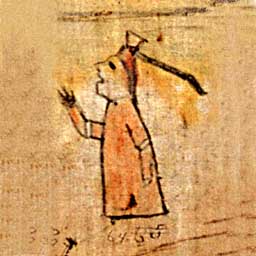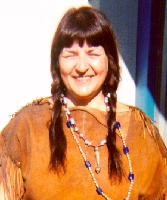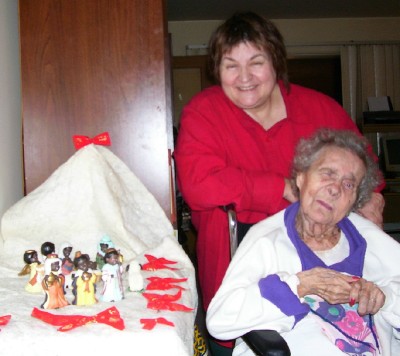ÉTIENNE BRŰLÉ
c.1592-1632
by Danielle Duval LeMyreE-MAIL: dlemyre@yahoo.com
Brűlé was a French/Huron & Algonquin Interpretor

Etienne Brűlé in the Land of the First Nation of the HURONS
Etienne was born around 1592
and was three years junior to
Etienne Brule, was a likeable young fellow who arrived in New-France in 1608, on the same ship as Nicolas Marsolet, a 16 years old youth, and Etienne adapted so well to the New World and it's native inhabitants that he fell readily in their ways, almost immediatly, and thrived. Yes, he was happy living as an Indian and with them, fathering several children with First Nations Women.
He soon had for friend anyone who was "fair" to the First Nations, especially, at the beginning, the Montagnais and Micmac nations. He generally got along with everyone, even with Samuel de Champlain who did complain about him, but who would chose him whenever a situation seemed "too dicey" and impossible to deal with, for Brűlé seemed to get out of any difficult situation... his curiosity and eagerness landed him in many scrapes... also he was fast tempered and it is said that he lost his own life on account of a man he had killed by hitting him on the head with an axe
* * * * * * * *
Wall painting: Man reputedly killed by Brulé with an ax

from website: http://eee.uci.edu/clients/tcthorne/wintercount/glyphs/glyph64.html
Correlates: Battiste Good, Flame, Cranbrook/Swift Dog, Lone Dog. Also Swan and Swift Bear (not shown). A tomahawk is sticking in the Kiowa's head. This man, described by a Wi-ta-pa-ha , a strange Indian, was killed by the Brule while the former was on a visit. Lone Dog says it was an Arapaho. Flame says a Brule was killed by Utes. The Cranbrook count says a Cheyenne was killed with an axe. The Swife bear count says a Shoshoni with a single arrow came to a Dakota lodge to make peace. (Mallery 1886: 108-109; 1893, 316; Praus 11; Finster 23; Cohen 1942, 20)
* * * * * * * *

A possible likeness of Samuel Champlain
Gouverneur
Yes, Champlain was Governor of New France, though he could not have been in Quebec too often since we have on record that Champlain did 30 trips between France and "la Nouvelle-France" between 1603 and his death on December 25th 1635, excluding the years 1629 and 1632 when he remained in France, (at which time he hired an historian/writer, for the first time, to record his Memoirs) after the English took over New France, after the brothers Kirke a.k.a. Kerth, took possession of Quebec. The Kirke brothers all spoke French well: they came from a French family who escaped to England because of their faith: they were Huguenot prostestants
It was a short possession, as Marsolet had tried to tell David Kirke, since Henriette de France, the Sister of King Louis XIV, was at the time given in marriage to the King of England and it was unlikely the two countries could actually be at war with each other... Marsolet was right, the land was given back to the French by 1632 and Louis XIV sent back those who were eager to go back and new settlers, except for the Recollet, which were forbidden to go back.. from then on, until they were themselves banned, only the Jesuits were sent to la Nouvelle-France. Their correspondance was the source of the very informative "Relations des Jesuites", which is probably the most complete accurate books of that period, though the Jesuits often used code names for the people in their letters.
So Etienne Brule spent time from 1608 to 1632 roaming the land, and the character depicted by all was of an eager young man who loved living and took full advantage of any opportunity for pleasure. He lived hard, hunting, drinking, loving and was not very responsible, but was so endearing by his frankness, courage and intrepidity.
Below is the Map of his known travels:

ETIENNE BRULE and some of his TRAVELS
Each year the fourth graders of many schools do special projects on the French exploration of Michigan.
Another way to look at Etienne Brule, in a more restrictive way, is as told at by:
Civilization.ca which says:
"It was Gabriel Sagard who, in 1624, discredited Brűlé in Champlain's eyes. The Récollet friar denounced the wandering adventurer's loose morals, and disclosed moreover that Brűlé was playing a double game: he was working at the same time for the administration of New France and for the fur merchants, who were opponents of Champlain.
Brűlé's reputation was blackened for ever in 1629. Champlain had capitulated to the Kirke brothers, and most of the French in the colony had returned to their homeland. At Tadoussac, Brűlé and his fellow interpreter Nicolas Marsolet admitted it was their intention to remain in New France. "We have been taken by force," was their excuse to Champlain, "and we know very well that if we were held in France we would be hung."
Brűlé was killed by the Hurons while the colony was still under the English (1629-1632).
The news reached Champlain when he returned to Quebec in 1633."

Champlain and Brűlé with their friends the Hurons, on Lake Simcoe on September 8 1615,
when they were all planning an attack on the Iroquois at Oneida, N.Y. - Brule was 23 years old.
The painting was by Rex Woods who is known for his keen historical research and his meticulous attention to detail.
This painting and the whole collection is on display in Toronto at the Head Office of the Confederation Life, 10th Floor, 321 Bloor St. East,
where visitors and students are welcome to see the "Gallery of Canadian History" which covers from 1497 to 1944.
25 of the paintings were the work of John David Kelly, who had been the official war artist of the North-West Rebellion of 1885 and
his last work was done in 1955 at age 95 for Confederation Life.
Other artists who painted for this magnificient collection who either worked with Mr. Kelly or alone, were H.B Goodridge, Bruce Stapleton, Thomas Mitchell and Rex Woods.
Etienne Brule probably also passed tru Detroit around 1625-26
and it is documented on the Detroit website.
Also as told by www.bartleby.com/65/br/Brule-Et.html on ETIENNE BRULE:
Etienne lived c.1592–1632 and he was a French explorer in North America.
He arrived (1608) in the New World with Samuel de Champlain, who sent him (1610) into the wilderness to learn about Native Americans and the land.
He lived with the Huron and accompanied (c.1612) a group of them to Georgian Bay of Lake Huron. In 1612 he guided Champlain to that lake, and on the return journey they were, so far as is known, the first Europeans to see Lake Ontario.
Brulé was then sent to the headwaters of the Susquehanna River and followed it to Chesapeake Bay. On his way back he was captured by the Iroquois and tortured, but he escaped (1618).
He lived with the Huron once again, making many explorations of which no definite record remains.
He probably visited Lake Superior and thus saw all the Great Lakes except perhaps Lake Michigan, being the first European to do so.
In 1629 he piloted the English vessels that captured Quebec
and his old commander, Champlain, ...which tells you
why Champlain held such a grudge against him.
It really was a case of "force majeure" since every one in the French colony had been starving for the last two years and also because both Brűlé and Marsolet could not consider Kirke's action very seriously since they knew of the coming marriage of Charles 1st of England and Henriette de France, sister of Louis XIII, and that a political settlement was in the offing.
As it was, most Europeans'lifestyles became distasteful to Brule and he chose to be more and more with the Huron tribes, and by the time the French came back, in 1632, things might have settled, when no one accused him formally of anything, but just then he was killed in a dispute.
He lived within several First Nations groups, travelling extensively and was when he was killed in 1632 it was reported by them that it was an act of reprisal because of another man who died when Brule struck him. He was a coureur des bois and a translator, a guide for the Jesuits.
Information taken from many sources, including:
C. W. Butterfield, History of Brulé’s Discoveries and Explorations, 1610–1626 (1898).
LINKS to other sites about Etienne Brűlé:
The Virtual Museum of New France offers
more on Etienne Brule and other early History.
N.B.: For more on Etienne Brule,
see the Canadiana site about the Hudson Bay www.canadiana.org/hbc/person/brule_e.html
* * * * * * * *
GOOGLE SEARCH ON "BRŰLÉ KILLED"
* * * * * * * *
Etienne Brule, c.1592-1632, French-Huron Interpretor by dlemyre ...
Brűlé was killed by the Hurons while the colony was still under the
English (1629-1632). The news reached Champlain when he returned to Quebec in 1633." ...
www.geocities.com/daniellla.geo/brule.html - 13k -
* * * * * * * *
'The Moving Wall' touches many during Warren stop
... Born Nov. 12, 1949. Army Cpl. Brule was killed in action on May 20, 1970, in Quang
Tin, South Vietnam. He is honored on Panel 10W, Row 69. Lester Michael DeRiso ...
www.eastbayri.com/story/281671375633175.php - 30k -
* * * * * * * *
Massacre Canyon
Estes said that one Brule was killed and three were mortally wounded. Janis said
non of the Cut-off Band were killed, and three were mortally wounded. ...
www.rootsweb.com/~nehitchc/history/canyon.html - 27k -
* * * * * * * *
| Book Review | The Journal of American History, 87.3 | The ...
Unfortunately, Brule was killed and eaten by the Hurons in 1632 and thus could
not comment on his earlier trip. 2. By the late 1600s the British had made ...
www.historycooperative.org/journals/jah/87.3/br_14.html -
* * * * * * * *
Timeline - AmerIndian
The French explorer Etienne Brule was killed by the Huron Indians for unknown
reasons. Links: AmerIndian Click to see the source(s) for this event ...
timelinesdb.com/listevents. php?subjid=486&title=AmerIndian - 56k -
* * * * * * * *
glyph64: 1814-1815
Flame says a Brule was killed by Utes. the Cranbrook count says a Cheyenne was
killed with an axe. the Swife Bear count says a Shoshoni with a single arrow ...
eee.uci.edu/clients/tcthorne/ wintercount/glyphs/glyph64.html - 2k -
* * * * * * * *
Timeline 1626-1660
1632 The French explorer Etienne Brule was killed by the Huron Indians for unknown
reasons. (HNQ, 6/29/98) 1632 In India Arjumand Shah Begum (aka Mumtaz ...
timelines.ws/1626_1660.HTML - 101k - 7 Nov 2005 -
* * * * * * * *
Timeline American Indians
1632 The French explorer Etienne Brule was killed by the Huron Indians for unknown
reasons. (HNQ, 6/29/98) 1636 Jul 20, John Oldham, trader in Mass., ...
timelines.ws/countries/AMERIND_B.HTML - 101k -
* * * * * * * *
History Mole: Exploration of Land & Sea (0150-1986)
1632, The French explorer Etienne Brule was killed by the Huron Indians for
unknown reasons. More:, Has external links associated with the geographic ...
www.historymole.com/cgi-bin/main/ results.pl?type=theme&theme=Exploration -
* * * * * * * *
Decades History Search
... Emajogi River. ref#3917. 1632, The French explorer Etienne Brule was killed
by the Huron Indians for unknown reasons. ref#3918. 1632, ...
www.decades.com/ByDecade/1630-1639/1.htm?tlvw=2 - 45k -
* * * * * * * * * * * * * * * *
CLICK HERE to see his picture by Charles William Jefferys
Sign our NEW GENEALOGY Guestbook
Signez votre visite
Signez votre visite
Dear Reader:
Myself, Danielle, am working primarily on the story of Brűlé's true friend,
Nicolas Marsolet story, since he was the first interpretor in New-France, chosen by Henri IV in 1589,
also on the Damours
and his Grand-daughter Charlotte Guyon D'Amours and her husband
the buccaneer St-Castin, who rescued Port-Royal from the British in 1707
BACK TO DANIELLA's GENEALOGY INDEX
at www.geocities.com/daniellla.geo
Danielle Duval LeMyre

Danielle - Celebrations 2000
* * * * * * * * * * * * * *

Danielle et Olga Obry LeMyre (1916-2006)
Thank you for your visit
Danielle - ddlemyre@yahoo.com -
514 236-0244
